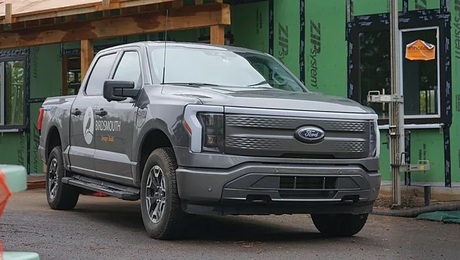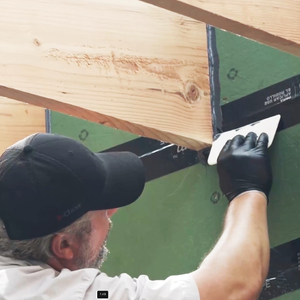|
I am shopping for ceiling fans, preferably energy efficient ones. Energy star rates the efficiency of a ceiling fans as a ratio of CFM/watts. I can understand the watts by comparing them to watts in light bulbs. However I do not know how to relate CFMs to every day life. How high a CFM do we need to feel comfortable on a hot and humid day, assuming no air conditioning? How low can the CFM be and still create enough air movement to retard mildew growth in a basement? Thanks. After posting the above in House Chat, Danno suggested I try Breaktime and give more information… We are building a house. All ceilings are 9′ high and flat. Fans are to be centered in the room. We have no A/C. 2 bedrooms in the basement are 9′ x 12′. The rec room in the basement is 12′ x 30′ (two fans). All basement rooms need fans that can run continuously on low in the summer to help retard mildew growth. Upstairs: 1 bedroom 11.5′ x 13.5′ and 1 bedroom 9.5′ x 11′; great room 18′ x 31′ (two fans), screened in porch 11.5 x 25′ (two fans). All fans in upstairs rooms will be used only for cooling comfort when room is occupied. Hope that helps. |
Discussion Forum
Discussion Forum
Up Next
Video Shorts
Featured Story

Ford Motor Company slashes prices for some F-150 Lightning models to stimulate demand for electric vehicles (EVs).
Featured Video
Builder’s Advocate: An Interview With ViewrailHighlights
"I have learned so much thanks to the searchable articles on the FHB website. I can confidently say that I expect to be a life-long subscriber." - M.K.

















Replies
Did you know there is no point in running a ceiling fan in an unoccupied room? Cooling effect is due to evaporation on skin from moving air.
Just curious
Yes. Upstairs we will use ceiling fans for cooling and only when rooms are occupied. But in the basement we will be using the ceiling fans to provide continuous air movement to discourage mildew growth during our humid summer.
I have always been a Hunter Fan fan (pun sort of intended) but you have to be careful of your source. Sam's and Wal-mart sometimes have them that I am surprised Hunter would put their name on. Lately I have used some of the Hampton Bay line that is a Home Depot store brand. They have some that are easy mount versions. They have the blade irons and light installed and the blades attach with a keyhole arrangement that snaps in.
It seems that most of the Hunters other than the top of the line ones do not have a lifetime warranty. Most of the Hampton are lifetime. I have installed many of them and usually do not have to track or balance.
I think Energy star is probably pretty much moot on a fan unless you are buying one of the very bottom of the barrel ones. Most use only about as much as a 60 watt bulb.
You may look into the relative energy costs of a ceiling fan and a small dehumidifier. IMO the later may be the way to go if you want to fight mildew.
I have read that a dehumidifier may also help keep a sump pump exercised. Having a sump pump fail it would be better if it did it while pumping out the tiny flow from a dehumidifier rather than the flow from the seasonal deluge.
I am in aggreement with 4Lorn1.
With ceiling fans you are nnot removing the moisture from the air, you are just pushing humid air around. It is still there and will become a source for moisture in the drywall, framing, carpet, etc. You need to lower the relative humidity of the basement to dry it old and prevent mold/mildew growth.
Since it is a basement, if you isolate it from the outside and up stairs, it will feel and be cooler with dehumidification. Most basement will naturally be cooler because the earth surrounding them acts as a heat sink that draws heat from inside the house. Normally that heat sink is near 45 to 55 degrees depending on depth and your location. With no additional heat sources in a basement, it will tend to equalize a temperature somewhere between earth temp and air temp.
Your ceiling fans will help with the senseable heat/cooling, but not the humidity.
Dave
You're assuming that the water vapor in the room is uniformly distributed. I can easily imagine that with the room air still, the air near the floor would have higher humidity than the air near the ceiling, such that mixing it up would bring the RH near the floor below the critical threshold for mildew growth.
You are most likely right, but he is talking about a new home, I think. There is a lot of water in dw finishing, painting, concrete, and even the framing lumber. Just stirring the air up to keep the humidity uniform in the air colum won't be enough, particularly if he is in a humid climate. There is just know where for the water vapor to go unless the RH outside is lower than it is inside. A 55 degree concrete wall will be as likely to be the condensing area as a floor if the dew point is near the same.
Dave
You imagination is wrong on this one. The vapor will be evenly distributed through out the space, without a point source. Moving the air ( or heating it or cooling it w/o condensation) will not affect the moisture content.
>> The vapor will be evenly distributed through out the space ...
I agree. And if the vapor is evenly distributed through out the space, then a temperature gradient will result in a relative humidity gradient. The RH near the floor will be higher than the RH near the ceiling. And mixing up the air with a ceiling fan will lower the RH near the floor.
The vapor will be evenly distributed through out the space
That is true, the absolute humidity tends to be constant in an unchanging volume of air. The wet bulb temperature will tend to stay constant for a given number of pounds of water vapor per cubic foot. The relative humidity will vary by the (dry bulb) temperature.
I get to live this effect. When it is "80° by 8" (0800) this time of year with a wet bulb temp of 75-78° the resultant RH is in the 90s. As it gets to "90 by 9," the RH drops proportionately, but not the absolute humidity (unless some other factor intervenes).
The differentials in RH are going to be proportionate to the temperature differentials. Mixing the two will tend to only average out the differences.
The rule of thumb I was taught two decades ago was that a fan would "give you" 2-5° on the cooling side of the psychometric chart, but that was only on the sensible heat, not the latent-from humidity--heat. Also, to get 5° you were up against the tolerance level for air velocity (where you did not leave the air stream to stay cool to chase all the things that just blew away in the breeze).
Back to the thread: Hunter is the only choice in fans that last. To better control both heat & basement humidity, it might be better (if not very easy) to have a "reverse" return air duct which brings the cooler (and moister) air up from the basement up to the warmest air in the highest portion of the house. This would need a fan on a timer or thermocouple.Occupational hazard of my occupation not being around (sorry Bubba)
Thanks for all the responses. I appreciate all the information about humidity. I will experiment to find out if continuous air movement (ceiling fans) really does anything to retard mildew growth. But I need ceiling fans for the experiment, so I still have the same question... When shopping for a ceiling fan for my mildew experiment, what is enough air movement? Is 1500 cfms enough or do I need 2500? I found one energy efficient fan that only uses 7 watts on low, but also turns only 55 rpms (the manufacturer does not give cfms). Would that create enough air movement? When the experiment is over, and I just want to feel a stiff cooling breeze, is that 5000 cfms or 9000? How do I know how much air a fan moves without installing it? Thanks again.
I am of the understanding that air movement also inhibits the growth of mildew. That is why I felt that a ceiling fan would help...not that is would reduce humidity.
Air movement, as such, won't have any affect.
However, I would expect that there are boundy conditions next to sources of moisture, such as a concrete wall. And while the moisture will diffuse into the whole room, that near the wall (I am talking 1/100 of an inch) the RH can be much higher.
Not usre if that applies here, but it does in not phyiscial properties. In that case air movement would help keep that area more uniform with the rest of the room.
I have found that the larger the CFM's the louder the noise. I have similiar room sizes and volumes and have found that 5 blade 52" fans work the best. We run our fans continuously from May to October, usually on the low speed.
I have not found a fan that outperforms a "Hunter" Thye run forever and are extremely quite. You will hear them on the High speed, but your hearing the air movement
The last one I installed had a great feature for easily attaching the blades after the unit is up... Also don't trust any electrical box not made for fan installs. I perfer the all metal ones.
all I can say is I'll only put top of the line Hunters in my own house ...
and ...
somewhere along the lines I heard a 4 blade model will actually move more air than a similar 5 blade model.
Jeff
Buck Construction, llc Pittsburgh,PA
Artistry in Carpentry
Have you seen the latest issue of Inpsired House? Has an article on ceiling fans and says divide square footage of room by four to get diameter of blade.
Gee, and I would have just used a ruler.
Yeah, but you gotta find the ruler and maybe get a ladder if the fan's up too high, etc.. ;-)
I run ceiling fans 24 hr day seven day a week all year round. Mine are about 12 years old now. nothing but Hunters, they really are quiet and dont vibrate. In fact I have had the a/c on less than five days this year and its 95 everyday, house stayed around 77 with fans. a ceiling fan really use less energy than a light bulb.